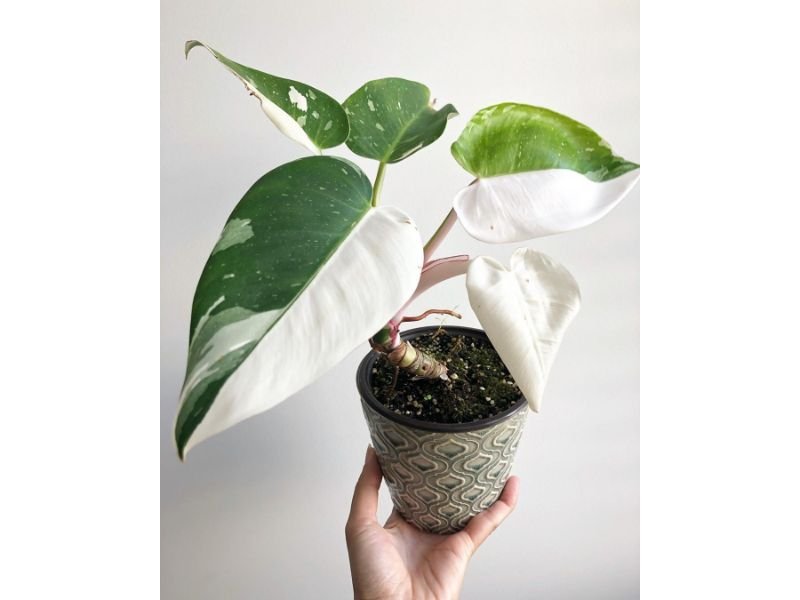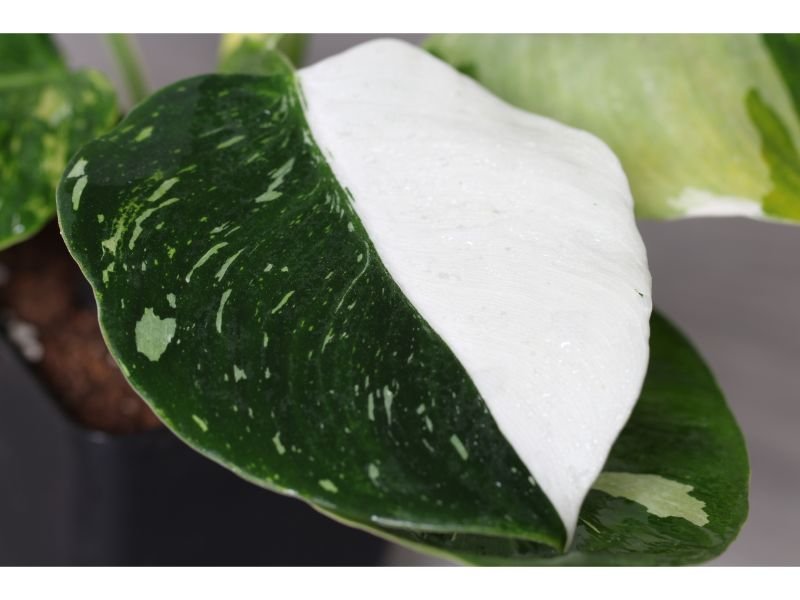Philodendron white wizard is a rare decorative and indoor plant from the family Araceae. With their striking and unique color combination of green and splattered white, philodendron white wizards shall add some charm to your house.

Table of Contents
Origin & Usage
The name philodendron is taken from the Greek words “Philo”, which means love, and “dendron”, which means tree. A native of Central and South America tropical forests, the philodendron white wizard is easy but slow to grow.
Physical attributes
One of the most distinguishing features of the white wizard philodendron from the other type of philodendron is their leaves color. They have green stems with heart-shaped green and variegated white big leaves.
The white distinctive color of their leaves almost makes it look as if they just spilled with white paint. On average, they grow as tall as 3 to 4 feet tall. Philodendron white wizards have aerial roots, which means their roots are growing above the ground.
Condition Requirement to grow
In general, every plant needs air, water, sunlight, nutrient-rich soil, and warmth to grow healthily. Philo white wizard is no exception.

Hardiness
As a tropical plant, the hardiness zone for philodendron white wizard is between 9-11, which covers the hottest and the most tropical area in their native habitat. This hardiness zone also means that cold temperature is rare and even during winter, the temperature is still warm.
Sunlight
The ideal temperature for a philodendron white wizard in order to grow is between 55 to 90 degrees Fahrenheit. You can place them in the warmest area where you plant them. But keep in mind to not place them in direct sunlight since it can burn their leaves. Philodendron white wizard needs partial sunlight, so place them in indirect sunlight like east-facing or west-facing windows.
Soil

Philodendron white wizard needs porous, fertile, and nutrient-rich soil. A pH value of 5.5 to 5.6 is good for them. For soil material, you can mix either sand, perlite, orchid bark, or coconut coir.
Care Guide
Growing a philodendron white wizard is not a difficult task to do. However, their growth process is slower than their philodendron counterpart. Thus, the philodendron white wizard makes a list of plants that are not easy to find. But with extra proper care and patience, it’s really possible to grow your own philodendron white wizard.
Planting
There are several ways to grow a philodendron white wizard. The first one is to grow this plant from seeds, but it’s not really recommended since it would take longer. You have to wait around 2 to 8 weeks for the seeds to germinate. Don’t forget to move the seeds once it’s starting to sprout to a new pot to get stronger root development. The second way is by air-layering the stem to another plant. You can do this step if your philodendron white wizard is too old. The third way is propagation, which is also a more recommended way that we will explain later.
Water
Philodendron white wizards do not need as much water as other plants. In fact, too much water can actually kill them. Watering three times a week and regularly spraying the leaves is ideal. This plant prefers high humidity, so you should also check the temperature. Depending on the season, it’s best to not water them too often, but also not leave them completely dry.
Fertilizer
A balanced 20-20-20 ratio of fertilizer is required. The main fertilizers like nitrogen, potassium, calcium, sulfur, and phosphorus could help you faster the growth process. Additional fertilizer like copper and iron is also needed. Do not over-fertilizing since it can do more harm than good to your plant. Choose the best commercial fertilizer possible. You can make your own fertilizer using natural ingredients like eggshells and coffee.
Pruning
Pruning has many benefits for your plants. You can prune when your philodendron takes too much space in your room or to prevent them from growing in unwanted directions.
The first thing you have to do is to decide whether your philodendron white wizard needs pruning or not.
If they do, you can start pruning by cutting off withered, dead, rotting, or diseased parts of the plant.
You can cut if the vines grow too long as well.
It’s safe to prune your philodendron white wizard at any time of year.
Harvest
Morning or evening is the best time to harvest a philodendron white wizard. In the morning, this plant absorbs a lot of water while in the afternoon, they gather a lot of nutrients from photosynthesizing during the previous morning hour. Thus, harvesting a philodendron white wizard during these two times would make the vase life last longer.
Propagation
As we discussed before, propagation is the most recommended way to grow a new philodendron white wizard. First, you need to cut 4 to 5 stems and place the cut stem into the soil material. Don’t forget to look at your stem and analyze it a little bit more to know its health, shape, thickness, and age.
Keep watering under the right temperature and keep them moist until the new roots grow. Another important thing to keep in mind is to provide them with stacks or tree trunks as a philodendron white wizard is a climbing plant.
Seasonal Precautions
Philodendron white wizards also have seasonal precautions that you need to keep an eye on. During spring and summer, you should keep the philodendron white wizard from the bright, direct sun and water them more often. During winter and fall, move your philodendron white wizard to an area with less light and also reduce the water intake to prevent them from rotting.
More articles about Philodendron
Common Problems
Some of the most common problems you can get when planting philodendron white wizard are these:
Why do the leaves of white wizard plants fall off?
This may be because of the lack of sunlight and water. The solution is to water them on time and move them to a place where there is more indirect sunlight exposure.
Why do the leaves of a philodendron white wizard grow abnormally?
If you find your philodendron white wizard has a change in its leaves, then the temperature may be the culprit. Low and high temperatures affect their leaf shape, and when that happens, you can’t revert the change and it requires pruning. Too low a temperature also can stunt their growth.
Why do the leaves of a Philo white wizard turn yellow, brown, or fading?
Philo white wizard’s leaves will turn yellow or fade when their soil moisture is improper. You should keep the soil damp, not too wet nor too dry. If the leaves turn a brown or dark color, it may be because of the watering problem. Too much or too light watering is not good, and you should water them evenly.
Why is my philodendron white wizard not growing?
It could be a mix of things. First, check your temperature and light where you plant them. Is it at the right temperature? Is the light too dark or too bright? Second, check if your philodendron white wizard needs repotting or not. Repotting can be done in late spring or early summer.
How to prevent my white wizard philodendron from rotting?
From poor drainage, over-watering, wrong temperature, pathogenic and bacterial infection, to not suitable pot size, those are common things that can cause your white wizard philodendron to rot. You can prevent this by regularly checking if there’s some material like rocks that block your plants’ drainage, removing the infected area by cutting, washing, and isolating the plant, and repotting your plant to fit its size.
How do I get rid of bugs, mites, and other insects?
Use and buy a low-toxic chemical pesticide. If you prefer the more natural way, you can rub alcohol or Neem oil all over the leaves and stems.
How to keep my white wizard Philo from reverting?
The three main keys to preventing reverting are to keep them from direct sunlight, water properly, and place them under the right temperature.
What is the difference between the philodendron white wizard, philodendron white knight, and philodendron pink princess?
They all come from the same Araceae family but differ in morphology. Philodendron white wizards have green stems, with green and splattered-white color leaves. They look similar to white knight philodendrons, the difference is in their stem color. White knight philodendrons have dark purplish stems. Meanwhile, the philodendron pink princess features half-green half-pink leaves and burgundy stems.
Pests and Diseases
Diseases caused by pest
Mealybugs are small white pests that harm your philodendron white wizard by feeding on their sap. It can cause yellow leaves, stunting their growth, or even cause death. You can use a chemical insecticide, rubbing alcohol, and Neem oil, or by applying soap water.

Diseases caused by fungi
Fungi like Rhizoctonia sp. can turn your white wizard philodendron to rot. You can prevent this by using a clean and sterilized pot and avoiding over-watering.
Diseases caused by bacteria
Erwinia carotovora causes soft rot and once your philodendron white wizard gets infected, the infection can spread very quickly, making an unpleasant fishy odor. Cut the infected area immediately and handle the plants carefully, especially when you want to wash them since they can spread both by hand and by splashing water.
Diseases caused by insect
Like mealybugs, insects like spider mites like to feed on your plants’ sap. To get rid of it, avoid them webbing on your plant and try to use a certain chemical or non-chemical anti-insect liquid.
Conclusion
Overall, the philodendron white wizard is not a demanding decorative plant. They take some time to grow but your patience will be worth it. Problems like rotting and pest disease can be easily remedied.

New author in the hood. Loves gardening and flowers are my spirit animals (yes I know they are not animals but I insist). I will be covering most of the flowers’ topics here and occasionally random though as well.






